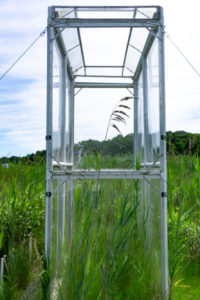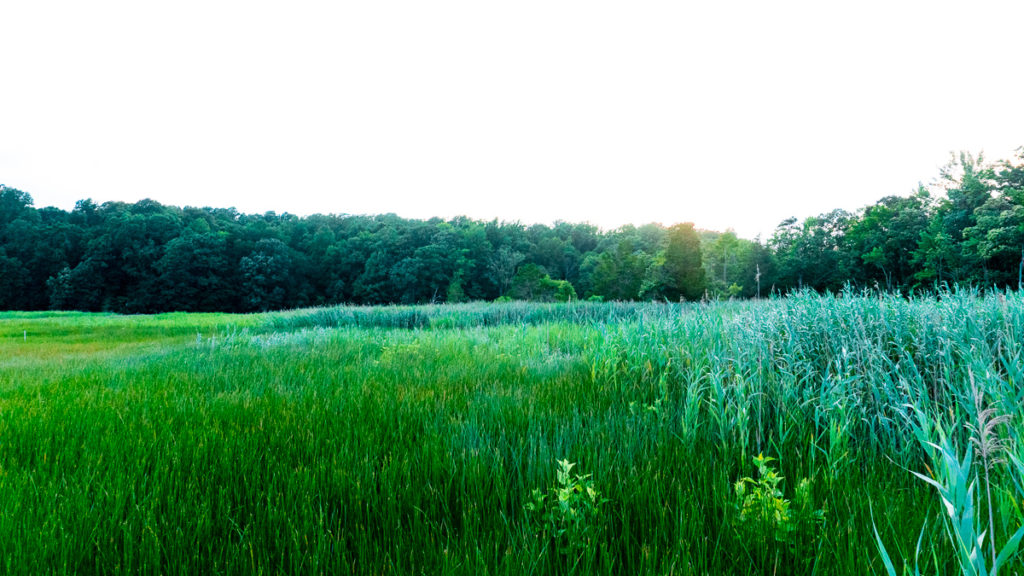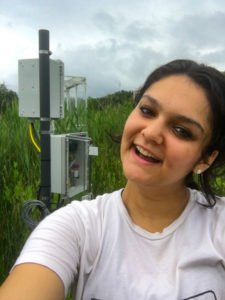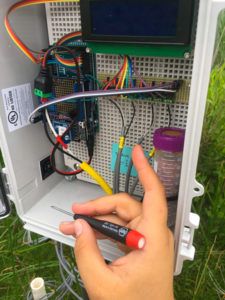By Philip Kiefer
Maya Bhalla-Ladd, who is beginning her second summer as an intern at the Smithsonian Environmental Research Center (SERC), didn’t think growing up that she would be a scientist. “In high school, I spent all my time on ballet,” she says. “I danced professionally. I lived on my own in New York.”
But when health problems forced her to turn away from ballet, she found herself drawn to the ocean. “I remember going to the aquarium as a kid and watching the rays,” she says. “The way they move is very naturally beautiful. So when I stopped being able to dance, I wanted to spend the rest of my life preserving that kind of natural beauty for other people to enjoy.”
Maya spent last summer at SERC’s Global Change Research Wetland (GCREW), investigating how climate change could affect photosynthesis in marsh plants. While there, she became fascinated with a tool used to measure photosynthesis in leaves. The tool seals a single leaf in a chamber and exposes it to light, causing the leaf to begin photosynthesis. It can then measure the precise gas composition of the chamber as the plant produces sugar. In effect, it can watch the plant breathe.
“I think that the instrumentation that enables science is so cool, and that we don’t spend enough time thinking about it,” Maya says.
This summer, she’s returned to SERC for a project focused specifically on the engineering required to run climate experiments. Maya is now working with Roy Rich, a forest ecologist at SERC, and Thomas Mozdzer, a former SERC postdoc and now visiting scientist. The team is studying how an invasive marsh reed called Phragmites australis might respond to climate change. To do that they must, in Rich’s words, “emulate the future.”
Step out onto the boardwalk of the GCREW, and you’ll find yourself surrounded by little windows into a future world. Clear plastic chambers dot the wetland, each containing a possible future atmosphere. Scientists at SERC hope to understand how the ecosystem will respond to a hotter, more carbon-rich planet by bringing that atmosphere into the here and now.

The Phragmites inside this chamber are being exposed to a possible future atmosphere. (Philip Kiefer/SERC)
But creating these future conditions means countering unexpected circumstances in the present.
“The chambers allow us to manipulate the environment, but they also change that environment,” says Maya. The chambers are meant to test the effect of increased nitrogen and carbon dioxide (CO2) on the Phragmites, but it’s unclear if the chambers themselves might create unexpected conditions, like variable temperatures.
The marsh is sliced apart by miles of rubber tubing, electrical wiring, and measuring devices, all humming along in salt water. Even a step that might seem simple to an outsider requires careful engineering. Maya’s project involves constructing and programming an instrument to measure the temperature of each chamber.
Each measuring instrument has a sensor that translates air temperature into an electrical signal. That signal is then passed to an open-source device called an Arduino board that can be programmed to record data on a computer. It’s possible to buy similar prefabricated instruments, but they cost thousands of dollars more. Instead, Maya and Rich assemble and code the systems by hand. On one recent afternoon, Maya sketched plans for a wiring system; on another, she cut PVC pipe to build a scaffold for the instruments.
“This kind of work is so different from anything I learn in school,” she says. “I like that every day forces me to learn something new to keep moving forward.”
So far, the results of the Phragmites project are double-edged. The invasive reeds flourish in a warmer, carbon-rich atmosphere, and that means that they might grow fast enough to avoid drowning in rising seas. But they also crowd out native marsh plants, which has led Pat Megonigal, the principal investigator of GCREW, to describe Phragmites as a “Jekyll and Hyde” plant: Phragmites might allow wetlands to survive rising sea levels, but at the cost of native biodiversity.
“The thing that worries me about climate change isn’t that the plants will all die. Warm and wet is really good for a lot of individual plants,” says Rich. “My worry is that when you start to introduce these processes so fast, you either lose ecosystem diversity or function.”
Studying the future world seems like it must necessarily be an exercise in abstraction, but research is almost never purely theoretical. In order to see what the future has in store, we need Maya and her lab mates to build it for us.

The interface between invading Phragmites reeds, on the right, and the native marsh at SERC. (Philip Kiefer/SERC)
Read more:
Jekyll or Hyde? The Many Faces of Phragmites
Cranking Up The Heat in the “Wetland of the Future”



